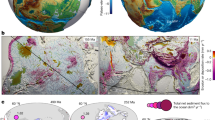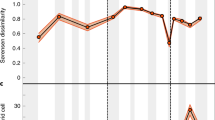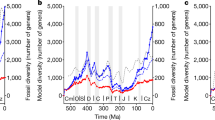Abstract
The diversity of life on Earth is controlled by hierarchical processes that interact over wide ranges of timescales1. Here, we consider the megaclimate regime2 at scales ≥1 million years (Myr). We focus on determining the domains of ‘wandering’ stochastic Earth system processes (‘Court Jester’3) and stabilizing biotic interactions that induce diversity dependence of fluctuations in macroevolutionary rates (‘Red Queen’4). Using state-of-the-art multiscale Haar and cross-Haar fluctuation analyses, we analysed the global genus-level Phanerozoic marine animal Paleobiology Database record of extinction rates (E), origination rates (O) and diversity (D) as well as sea water palaeotemperatures (T). Over the entire observed range from several million years to several hundred million years, we found that the fluctuations of T, E and O showed time-scaling behaviour. The megaclimate was characterized by positive scaling exponents—it is therefore apparently unstable. E and O are also scaling but with negative exponents—stable behaviour that is biotically mediated. For D, there were two regimes with a crossover at critical timescale \(\Delta {t}_{{\rm{trans}}}\) ≈ 40 Myr. For shorter timescales, D exhibited nearly the same positive scaling as the megaclimate palaeotemperatures, whereas for longer timescales it tracks the scaling of macroevolutionary rates. At scales of at least \(\Delta {t}_{{\rm{trans}}}\) there is onset of diversity dependence of E and O, probably enabled by mixing and synchronization (globalization) of the biota by geodispersal (‘Geo-Red Queen’).
This is a preview of subscription content, access via your institution
Access options
Access Nature and 54 other Nature Portfolio journals
Get Nature+, our best-value online-access subscription
$29.99 / 30 days
cancel any time
Subscribe to this journal
Receive 51 print issues and online access
$199.00 per year
only $3.90 per issue
Buy this article
- Purchase on Springer Link
- Instant access to full article PDF
Prices may be subject to local taxes which are calculated during checkout




Similar content being viewed by others
Data availability
The palaeobiological genus occurrence data are freely available for download in the Paleobiology Database https://paleobiodb.org/data1.2/occs/list.csv?datainfo&rowcount&base_name=Animalia&taxon_reso=genus&pres=regular&interval=cambrian,quaternary&envtype=marine. Other data—palaeotemperatures, tectonic rates and sea levels are available as supplementary data in the original cited articles.
Code availability
Macroevolutionary metrics were calculated in R v.3.6.0 using functions available in divDyn package. The scripts needed for the Phanerozoic-scale analysis of marine diversity with divDyn can be found at https://github.com/divDyn/ddPhanero/. Haar fluctuation, scaling and cross-Haar analyses were done using Mathematica custom-made code and can be accessed at http://www.physics.mcgill.ca/~gang/software/index.html.
References
Gould, S. J. The Structure of Evolutionary Theory (Harvard Univ. Press, 2002).
Lovejoy, S. A voyage through scales, a missing quadrillion and why the climate is not what you expect. Clim. Dynam. 44, 3187–3210 (2015).
Barnosky, A. D. Distinguishing the effects of the Red Queen and Court Jester on Miocene mammal evolution in the northern Rocky Mountains. J. Vertebr. Paleontol. 21, 172–185 (2001).
Van Valen, L. A new evolutionary law. Evol. Theory 1, 1–30 (1973).
Sepkoski, J. J. J. in Evolutionary Paleobiology (eds Jablonski, D. et al.) 211–255 (Univ. of Chicago Press, 1996).
Cornette, J. L. & Lieberman, B. S. Random walks in the history of life. Proc. Natl Acad. Sci. USA 101, 187–191 (2004).
Hoffman, A. in Neutral Models in Biology (eds Nitecki, M. H. & Hoffman, A.)133–146 (Oxford Univ. Press, 1987).
Benton, M. J. The Red Queen and the Court Jester: species diversity and the role of biotic and abiotic factors through time. Science 323, 728–732 (2009).
Alroy, J. The shifting balance of diversity among major marine animal groups. Science 329, 1191–1194 (2010).
Alroy, J. Geographical, environmental and intrinsic biotic controls on Phanerozoic marine diversification. Palaeontology 53, 1211–1235 (2010).
Close, R. A. et al. The apparent exponential radiation of Phanerozoic land vertebrates is an artefact of spatial sampling biases. Proc. R. Soc. B 287, 20200372 (2020).
Foote, M. in Evolution after Darwin: The first 150 years (eds Bell, M. A. et al.) 479–510 (Sinauer Associates, 2010).
Foote, M., Cooper, R. A., Crampton, J. S. & Sadler, P. M. Diversity-dependent evolutionary rates in early Palaeozoic zooplankton. Proc. R. Soc. B 285, 20180122 (2018).
Alroy, J. et al. Phanerozoic trends in the global diversity of marine invertebrates. Science 321, 97–100 (2008).
Lovejoy, S. Spectra, intermittency, and extremes of weather, macroweather and climate. Sci. Rep. 8, 12697 (2018).
Eichenseer, K. et al. Jurassic shift from abiotic to biotic control on marine ecological success. Nat. Geosci. 12, 638–642 (2019).
Patzkowsky, M. E. Origin and evolution of regional biotas: a deep-time perspective. Annu. Rev. Earth Planet. Sci. 45, 471–495 (2017).
Jablonski, D. Approaches to macroevolution: 2. Sorting of variation, some overarching issues, and general conclusions. Evol. Biol. 44, 451–475 (2017).
Rosenzweig, M. L. Species Diversity in Space and Time (Cambridge Univ Press, 1995).
Gould, S. J. The paradox of the first tier: an agenda for paleobiology. Paleobiology 11, 2–12 (1985).
Erwin, D. H. in Chance in Evolution (eds Ramsey, G. & and Pence, C. H.) 279–298 (Univ. Chicago Press, 2016).
Jablonski, D. Scale and hierarchy in macroevolution. Palaeontology 50, 87–109 (2007).
Jablonski, D. Approaches to macroevolution: 1. General concepts and origin of variation. Evol. Biol. 44, 427–450 (2017).
Newman, M. & Palmer, R. Modeling Extinction (Oxford Univ. Press, 2003).
Lovejoy, S. & Schertzer, D. Haar wavelets, fluctuations and structure functions: convenient choices for geophysics. Nonlin. Processes Geophys. 19, 513–527 (2012).
Plotnick, R. E. & Sepkoski, J. J. J. A multiplicative multifractal model of originations and extinctions. Paleobiology 27, 126–139 (2001).
Alroy, J. A more precise speciation and extinction rate estimator. Paleobiology 41, 633–639 (2015).
Song, H., Wignall, P. B., Song, H., Dai, X. & Chu, D. Seawater temperature and dissolved oxygen over the past 500 million years. J. Earth Sci. 30, 236–243 (2019).
Veizer, J. et al. 87Sr/86Sr, δ13C and δ18O evolution of Phanerozoic seawater. Chem. Geol. 161, 59–88 (1999).
O’Brien, C. L. et al. Cretaceous sea-surface temperature evolution: constraints from TEX86 and planktonic foraminiferal oxygen isotopes. Earth Sci. Rev. 172, 224–247 (2017).
Lovejoy, S. Weather, Macroweather, and the Climate: Our Random Yet Predictable Atmosphere (Oxford Univ. Press, 2019).
Cuthill, J. F. H., Guttenberg, N. & Budd, G. E. Impacts of speciation and extinction measured by an evolutionary decay clock. Nature 588, 636–641 (2020).
Crampton, J. S., Cooper, R. A., Sadler, P. M. & Foote, M. Greenhouse–icehouse transition in the Late Ordovician marks a step change in extinction regime in the marine plankton. Proc. Natl Acad. Sci. USA 113, 1498–1503 (2016).
Van Dam, J. A. et al. Long-period astronomical forcing of mammal turnover. Nature 443, 687–691 (2006).
Erwin, D. H. Seeds of diversity. Science 308, 1752–1753 (2005).
Roopnarine, P. D. Extinction cascades and catastrophe in ancient food webs. Paleobiology 32, 1–19 (2006).
Close, R. A., Benson, R. B. J., Saupe, E. E., Clapham, M. E. & Butler, R. J. The spatial structure of Phanerozoic marine animal diversity. Science 368, 420–424 (2020).
Eldredge, N. Unfinished Synthesis: Biological Hierarchies and Modern Evolutionary Thought (Oxford Univ. Press, 1985).
Lieberman, B. S., MillerIII, W. & Eldredge, N. Paleontological patterns, macroecological dynamics and the evolutionary process. Evol. Biol. 34, 28–48 (2007).
Stigall, A. L. Invasive species and biodiversity crises: testing the link in the Late Devonian. PLoS ONE 5, e15584 (2010).
Lam, A. R., Stigall, A. L. & Matzke, N. J. Dispersal in the Ordovician: speciation patterns and paleobiogeographic analyses of brachiopods and trilobites. Palaeogeogr. Palaeoclimatol. Palaeoecol. 489, 147–165 (2018).
DeMets, C., Gordon, R. G., Argus, D. F. & Stein, S. Current plate motions. Geophys. J. Int. 101, 425–478 (1990).
Valentine, J. W., Foin, T. C. & Peart, D. A provincial model of Phanerozoic marine diversity. Paleobiology 4, 55–66 (1978).
Button, D. J., Lloyd, G. T., Ezcurra, M. D. & Butler, R. J. Mass extinctions drove increased global faunal cosmopolitanism on the supercontinent Pangaea. Nat. Commun. 8, 733 (2017).
Spiridonov, A. et al. Integrated record of Ludlow (Upper Silurian) oceanic geobioevents—coordination of changes in conodont, and brachiopod faunas, and stable isotopes. Gondwana Res. 51, 272–288 (2017).
Sheehan, P. & Coorough, P. Brachiopod zoogeography across the Ordovician–Silurian extinction event. Geol. Soc. Lond. Mem. 12, 181–187 (1990).
Borrelli, J. J. et al. Selection on stability across ecological scales. Trends Ecol. Evol. 30, 417–425 (2015).
Stanley, S. M. Predation defeats competition on the seafloor. Paleobiology 34, 1–21 (2008).
Spiridonov, A., Brazauskas, A. & Radzevičius, S. Dynamics of abundance of the mid- to late Pridoli conodonts from the eastern part of the Silurian Baltic Basin: multifractals, state shifts, and oscillations. Am. J. Sci. 316, 363–400 (2016).
Lovejoy, S. & Schertzer, D. The Weather and Climate: Emergent Laws and Multifractal Cascades (Cambridge Univ. Press, 2013).
Cornette, J. L., Lieberman, B. S. & Goldstein, R. H. Documenting a significant relationship between macroevolutionary origination rates and Phanerozoic pCO2 levels. Proc. Natl Acad. Sci. USA 99, 7832–7835 (2002).
Hannisdal, B. & Peters, S. E. Phanerozoic Earth system evolution and marine biodiversity. Science 334, 1121–1124 (2011).
Mayhew, P. J., Bell, M. A., Benton, T. G. & McGowan, A. J. Biodiversity tracks temperature over time. Proc. Natl Acad. Sci. USA 109, 15141–15145 (2012).
Mathes, G. H., van Dijk, J., Kiessling, W. & Steinbauer, M. J. Extinction risk controlled by interaction of long-term and short-term climate change. Nat. Ecol. Evol. 5, 304–310 (2021).
Mathes, G. H., Kiessling, W. & Steinbauer, M. J. Deep-time climate legacies affect origination rates of marine genera. Proc. Natl Acad. Sci. USA 118, e2105769118 (2021).
Roberts, G. G. & Mannion, P. D. Timing and periodicity of Phanerozoic marine biodiversity and environmental change. Sci. Rep. 9, 6116 (2019).
Žliobaitė, I. & Fortelius, M. On calibrating the completometer for the mammalian fossil record. Paleobiology 48, 1–11 (2021).
Valentine, J. W. & Walker, T. D. Diversity trends within a model taxonomic hierarchy. Physica D 22, 31–42 (1986).
Sepkoski, J. J. & Kendrick, D. C. Numerical experiments with model monophyletic and paraphyletic taxa. Paleobiology 19, 168–184 (1993).
Crampton, J. S., Cooper, R. A., Foote, M. & Sadler, P. M. Ephemeral species in the fossil record? Synchronous coupling of macroevolutionary dynamics in mid-Paleozoic zooplankton. Paleobiology 46, 123–135 (2020).
Sepkoski, J. J. Ten years in the library: new data confirm paleontological patterns. Paleobiology 19, 43–51 (1993).
Alroy, J. Successive approximations of diversity curves: ten more years in the library. Geology 28, 1023–1026 (2000).
R Core Team. R: A Language and Environment for Statistical Computing (R Foundation for Statistical Computing, 2015).
Kocsis, A. T., Reddin, C. J., Alroy, J. & Kiessling, W. The R package divDyn for quantifying diversity dynamics using fossil sampling data. Methods Ecol. Evol. 10, 735–743 (2019).
Kocsis, A. T., Alroy, J., Reddin, C. J. & Kiessling, W. Phanerozoic-scale global marine biodiversity analysis with the R package divDyn v0.7. divDyn vignette (2019).
Na, L. & Kiessling, W. Diversity partitioning during the Cambrian radiation. Proc. Natl Acad. Sci. USA 112, 4702–4706 (2015).
Fan, J.-x et al. A high-resolution summary of Cambrian to Early Triassic marine invertebrate biodiversity. Science 367, 272–277 (2020).
Raup, D. M. Cohort analysis of generic survivorship. Paleobiology 4, 1–15 (1978).
Raup, D. M. Mathematical models of cladogenesis. Paleobiology 11, 42–52 (1985).
Foote, M. Pulsed origination and extinction in the marine realm. Paleobiology 40, 6–20 (2005).
Payne, J. L. & Heim, N. A. Body size, sampling completeness, and extinction risk in the marine fossil record. Paleobiology 46, 23–40 (2020).
Hearing, T. W. et al. An early Cambrian greenhouse climate. Sci. Adv. 4, eaar5690 (2018).
Goldberg, S. L., Present, T. M., Finnegan, S. & Bergmann, K. D. A high-resolution record of early Paleozoic climate. Proc. Natl Acad. Sci. USA 118, e2013083118 (2021).
Schrag, D. P., DePaolo, D. J. & Richter, F. M. Reconstructing past sea surface temperatures: correcting for diagenesis of bulk marine carbonate. Geochim. Cosmochim. Acta 59, 2265–2278 (1995).
Miller, K. G. et al. The Phanerozoic record of global sea-level change. Science 310, 1293–1298 (2005).
Van der Meer, D. et al. Reconstructing first-order changes in sea level during the Phanerozoic and Neoproterozoic using strontium isotopes. Gondwana Res. 44, 22–34 (2017).
Müller, R. D. & Dutkiewicz, A. Oceanic crustal carbon cycle drives 26-million-year atmospheric carbon dioxide periodicities. Sci. Adv. 4, eaaq0500 (2018).
Kiessling, W. Long-term relationships between ecological stability and biodiversity in Phanerozoic reefs. Nature 433, 410–413 (2005).
McKinney, M. L. & Oyen, C. W. Causation and nonrandomness in biological and geological time series: temperature as a proximal control of extinction and diversity. Palaios 4, 3–15 (1989).
Haar, A. Zur theorie der orthogonalen funktionensysteme. Math. Ann. 69, 331–371 (1910).
Acknowledgements
We thank A. Kocsis for help with divDyn package functions. We also thank many contributors to the Paleobiology Database and the authors of descriptive taxonomic papers and geochemical analyses that generated the primary data used in this study. This research was supported by project S-MIP-21-9 ‘The role of spatial structuring in major transitions in macroevolution’. S.L. acknowledges the National Science and Engineering Council for some support. This paper is Paleobiology Database official publication 426.
Author information
Authors and Affiliations
Contributions
A.S. and S.L. developed the design of the study, analysed the data and wrote the text.
Corresponding authors
Ethics declarations
Competing interests
The authors declare no competing interests.
Peer review
Peer review information
Nature thanks Jurgen Kurths, Gene Hunt, Appy Sluijs and the other, anonymous, reviewer(s) for their contribution to the peer review of this work. Peer reviewer reports are available.
Additional information
Publisher’s note Springer Nature remains neutral with regard to jurisdictional claims in published maps and institutional affiliations.
Extended data figures and tables
Extended Data Fig. 1 Macroevolutionary and paleoclimate time series.
A. Average global surface water temperatures (T) Song and others (2019) data28, B marine animal genus diversity (D), C second-for-third genus extinction rates per bin (E), D second-for-third origination rates per bin (O). Paleobiological patterns are per bin averages with \(\pm \sigma \) confidence intervals based on 100 bootstrap replications.
Extended Data Fig. 2 Paleoclimate time series and time scaling.
A. Song et al., 2019 (blue) and Veizer et al., 1999 (red) global sea water paleotemperature stacks32,33 expressed in \(\delta {}^{18}O\) ‰ units as a function of age (time flows from right to left). The Song et al., 2019 data was standardized by setting mean to zero and standard deviations were made equal. B Cretaceous sea surface water temperatures based on TEX86 and \(\delta {}^{18}O_{pl}\) data73 for low latitudes (black) [n = 2856 temperature estimates] and high latitudes (red)[n = 638 temperature estimates] in °C. C. Haar fluctuation scaling curves for high latitude (pink), and low latitude (brown) Cretaceous sea surface temperatures (in °C); timescales shown in \({\log }_{10}\) Myr; dashed line shows scaling pattern with H = +0.25.
Extended Data Fig. 4 Time-dependant correlations.
scale-dependant correlations of fluctuations in A extinction rates with temperatures, time in Myr. Same for B origination rates with temperatures; C global diversity levels with extinction rates; D global diversity levels with origination rates. Mean (black) and one standard deviation confidence limits dashed red. Mean (black) and one standard deviation confidence limits dashed red (16–84%).
Extended Data Fig. 5 Time scaling of the global sea level and sea floor spreading.
Haar fluctuation scaling of the sea level75 (in m from the present level) during the Phanerozoic and Neoproterozoic (brown), and of the sea floor production rates76 through the Meso-Cenozoic (m2/year /3 x 104) (pink). Timescales shown in \({\log }_{10}\) Myr. Both geophyscal variables scale positively at least to the timescale of 100 Myr. \(\varDelta {t}_{trans}\) signifies critical transition time from the positive to the negative diversity scaling, and the start of synchronization of macroevolutionary rates. Sea level and tectonic activity scales positively well beyound this critical threshold.
Supplementary information
Supplementary Information
Discussion of uncertainties in the estimation of scaling relations and correlation of scaling time series and Supplementary Figs. 1–5 and references.
Rights and permissions
About this article
Cite this article
Spiridonov, A., Lovejoy, S. Life rather than climate influences diversity at scales greater than 40 million years. Nature 607, 307–312 (2022). https://doi.org/10.1038/s41586-022-04867-y
Received:
Accepted:
Published:
Issue Date:
DOI: https://doi.org/10.1038/s41586-022-04867-y
This article is cited by
-
Decoupling speciation and extinction reveals both abiotic and biotic drivers shaped 250 million years of diversity in crocodile-line archosaurs
Nature Ecology & Evolution (2023)
-
Bayesian analyses indicate bivalves did not drive the downfall of brachiopods following the Permian-Triassic mass extinction
Nature Communications (2023)
-
Spatial pattern of marine oxygenation set by tectonic and ecological drivers over the Phanerozoic
Nature Geoscience (2023)
-
Scaling in the Evolution of Biodiversity
Biological Theory (2023)
-
Role of Taxa Age and Geologic Range: Survival Analysis of Marine Biota over the Last 538 Million Years
Journal of Agricultural, Biological and Environmental Statistics (2023)
Comments
By submitting a comment you agree to abide by our Terms and Community Guidelines. If you find something abusive or that does not comply with our terms or guidelines please flag it as inappropriate.



